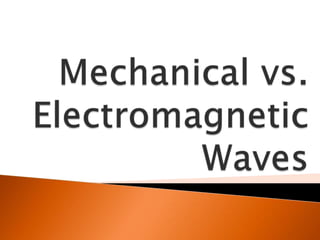
Mechanical vs electromagnetic waves
- 2. In this activity, you will differentiate between mechanical waves and electromagnetic waves.
- 3. 1. When you created waves using a rope in Activity 1 Part A, you were able to observe a moving pattern. In this case, the medium of wave propagation is the rope. a. In Activity 1 Part B, what is the medium of wave propagation? b. In Activity 1 Part C, what is the medium of wave propagation?
- 4. 2.The waves that you have created in Activity 1 all require a medium for wave propagation. They are called mechanical waves. a. How can you generate mechanical waves?
- 5. The medium of propagation for the wave shown is the rope.
- 6. 3.All three kinds of waves – transverse, longitudinal, and surface – are sent out by an earthquake and can be detected many thousands of kilometers away if the quake is a major one.
- 7. a. What do you think is the source of earthquake waves? b. What is the medium of propagation of earthquake waves?
- 8. 1.Energy from the sun reaches the earth through electromagnetic waves. As opposed to mechanical waves, electromagnetic waves require no material medium for their passage. Thus, they can pass through empty space.
- 9. 2.The electromagnetic spectrum shows the various types of electromagnetic waves, the range of their frequencies and wavelength. The wave speed of all electromagnetic waves is the same and equal to the speed of light which is approximately equal to 300 000 000 m/s.
- 11. 1.Describe the relationship between frequency and wavelength of each electromagnetic wave.
- 12. 2.Boardwork:Draw waves to represent each electromagnetic wave. Your illustrations must represent the wavelength of a wave relative to the others. For instance, gamma rays have a very small wavelength compared to the other waves in the spectrum.
- 13. The Sun is an important source of ultraviolet (UV) waves, which is the main cause of sunburn. Sunscreen lotions are transparent to visible light but absorb most UV light. The higher a sunscreen’s solar protection factor (SPF), the greater the percentage of UV light absorbed. Why are UV rays harmful to the skin compared to visible light?
- 14. 1. Mechanical waves like sound, water waves, earthquake waves, and waves in a stretched string propagate through a _______ while _______ waves such as radio waves, visible light, and gamma rays, do not require a material medium for their passage.
- 15. Theactivities that you have performed are all about wave motion or the propagation of a pattern caused by a vibration. Waves transport energy from one place to another thus they can set objects into motion.
- 16. Activity1 introduced you to transverse waves, longitudinal waves, and surface waves. You observed the motion of a segment of the material through which the wave travels. (Compare and Contrast)
- 17. 1.Transverse waves occur when the individual particles or segments of a medium vibrate from side to side perpendicular to the direction in which the waves travel.
- 18. 2.Longitudinal waves occur when the individual particles of a medium vibrate back and forth in the direction in which the waves travel.
- 19. 3.The motion of water molecules on the surface of deep water in which a wave is propagating is a combination of transverse and longitudinal displacements, with the result that molecules at the surface move in nearly circular paths. Each molecule is displaced both horizontally and vertically from its normal position.
- 20. 4.While energy is transported by virtue of the moving pattern, it is important to remember that there is no net transport of matter in wave motion. The particles vibrate about a normal position and do not undergo a net motion.
- 21. In Activity 2, you have encountered the important terms and quantities used to describe periodic waves. 1. The crest and trough refer to the highest point and lowest point of a wave pattern, respectively.
- 22. 2.The amplitude of a wave is the maximum displacement of a particle of the medium on either side of its normal position when the wave passes.
- 23. 3.The frequency of periodic waves is the number of waves that pass a particular point for every one second while the wavelength is the distance between adjacent crests or troughs.
- 24. 4.The period is the time required for one complete wave to pass a particular point.
- 25. 5. The speed of the wave refers to the distance the wave travels per unit time. It is related to the frequency of the wave and wavelength through the following equation: = ℎ
- 26. Finally, Activity 3 prompted you to distinguish between mechanical and electromagnetic waves.
- 27. 1.In mechanical waves, some physical medium is being disturbed for the wave to propagate. A wave traveling on a string would not exist without the string. Sound waves could not travel through air if there were no air molecules.
- 28. With mechanical waves, what we interpret as a wave corresponds to the propagation of a disturbance through a medium.
- 29. 2.On the other hand, electromagnetic waves do not require a medium to propagate; some examples of electromagnetic waves are visible light, radio waves, television signals, and x-rays.
